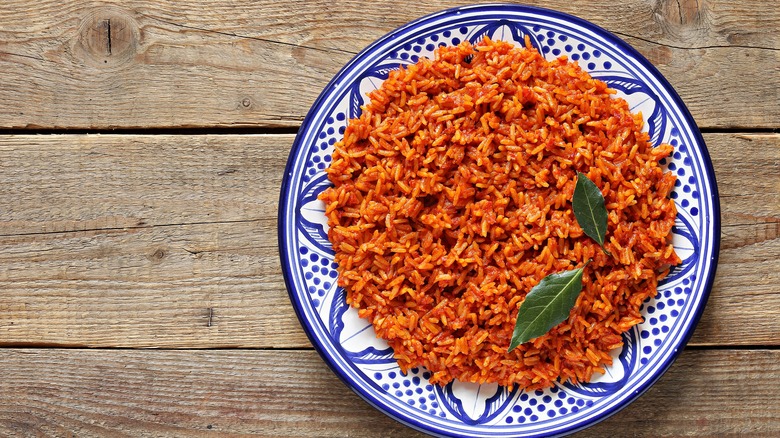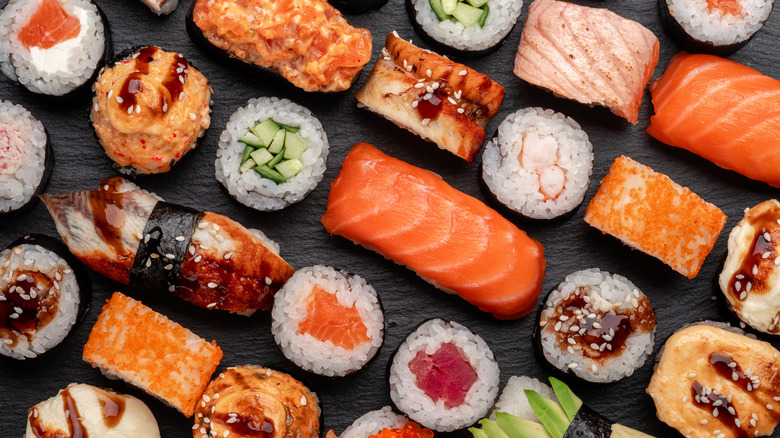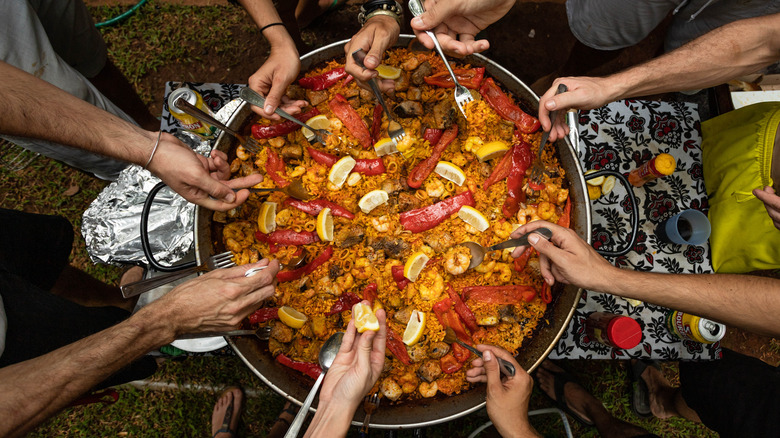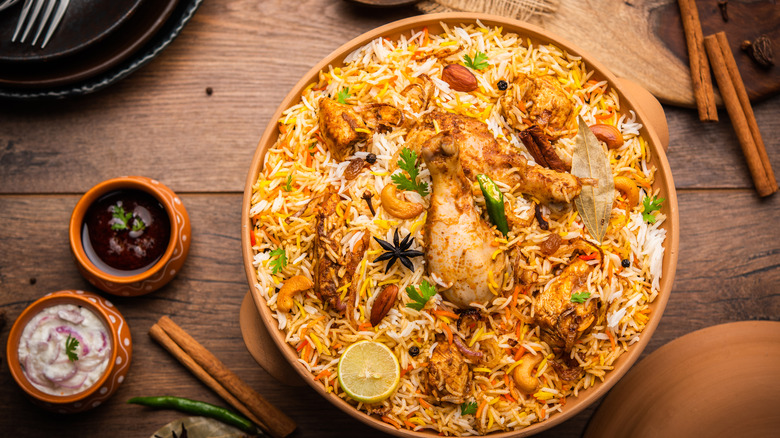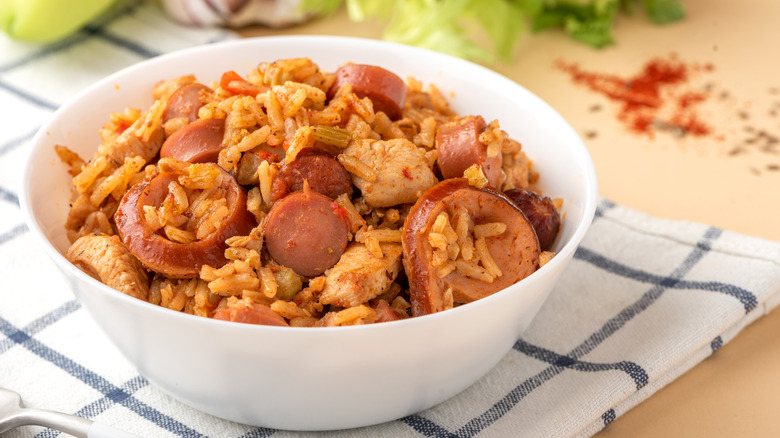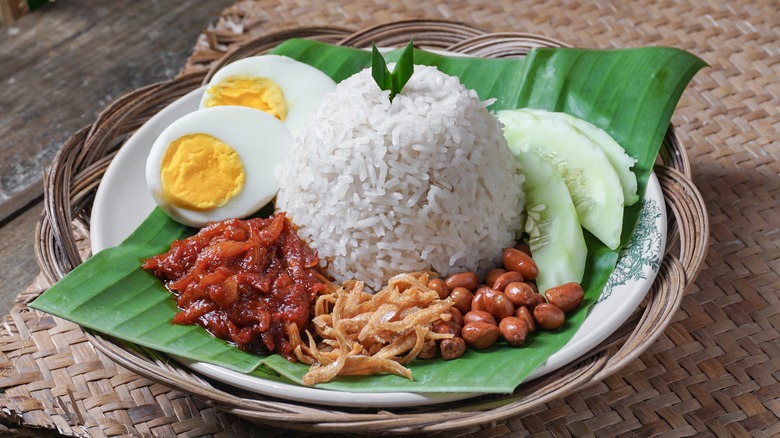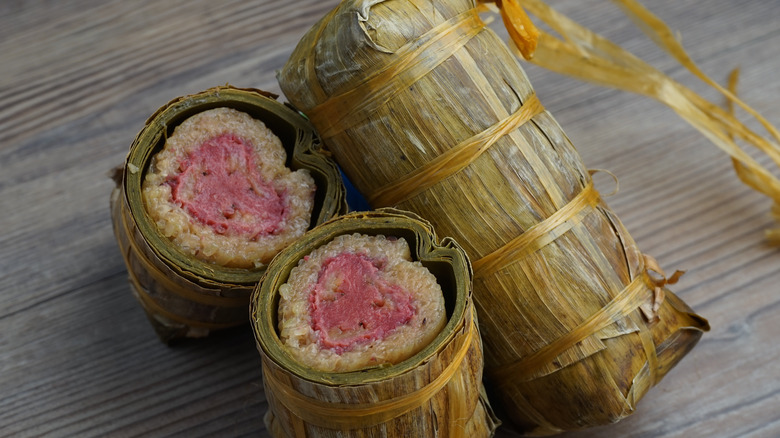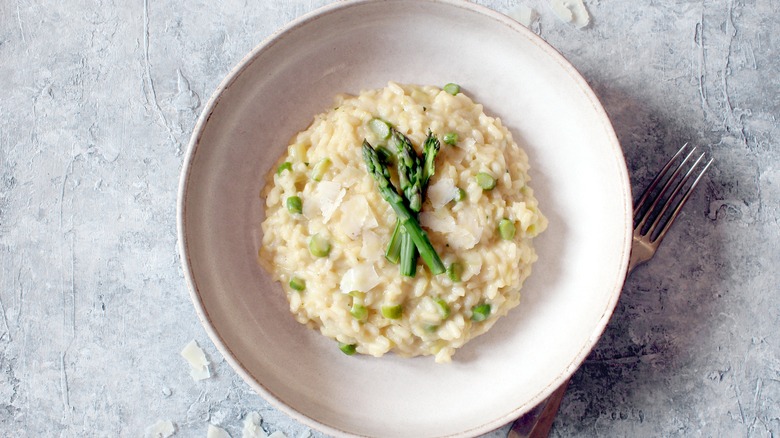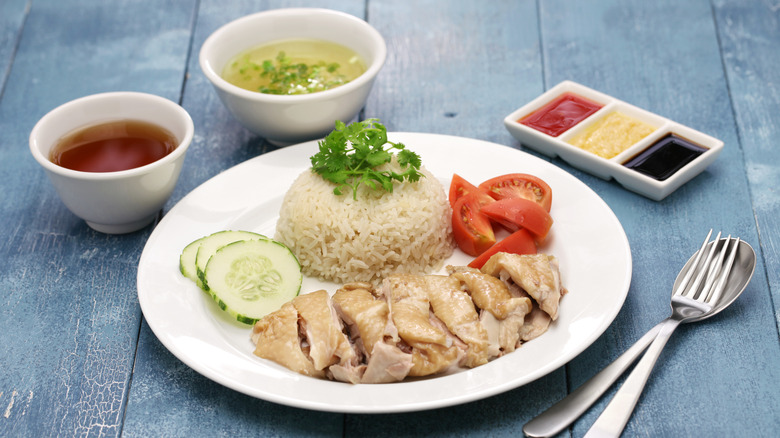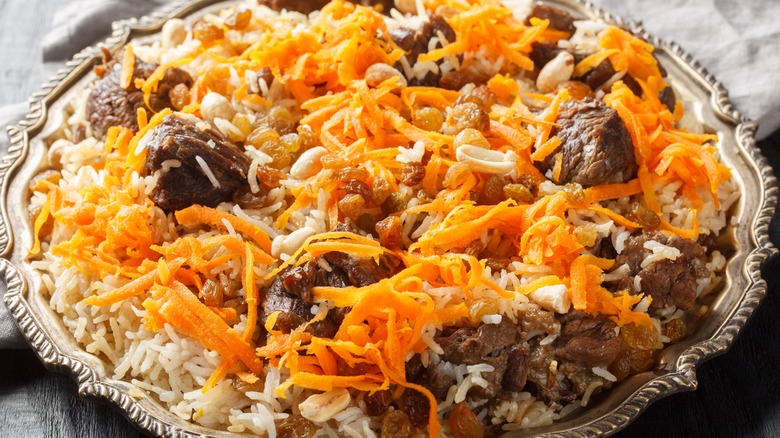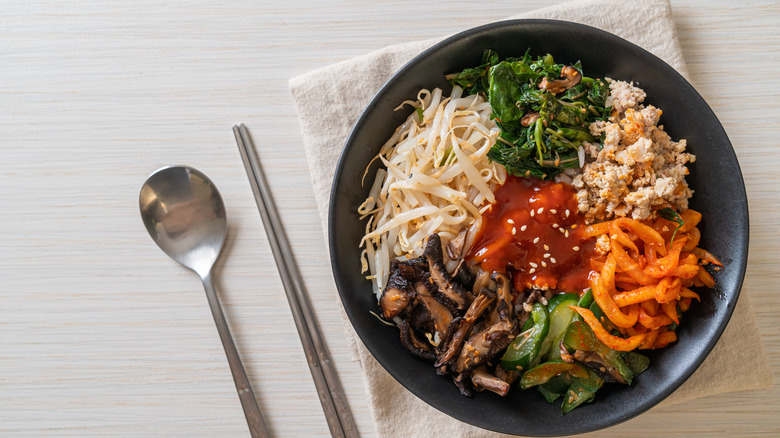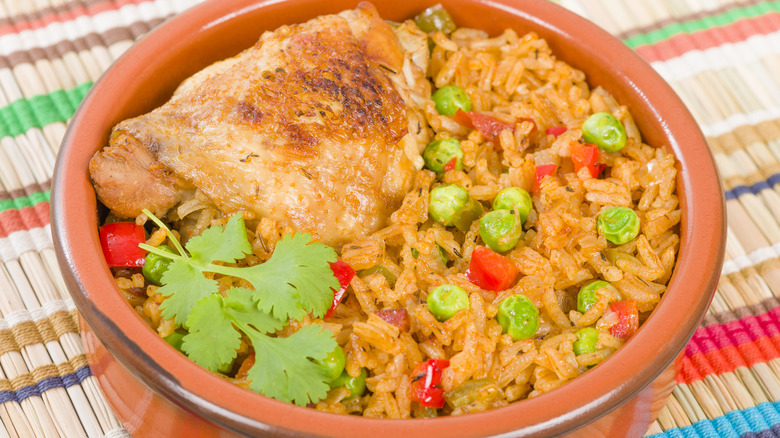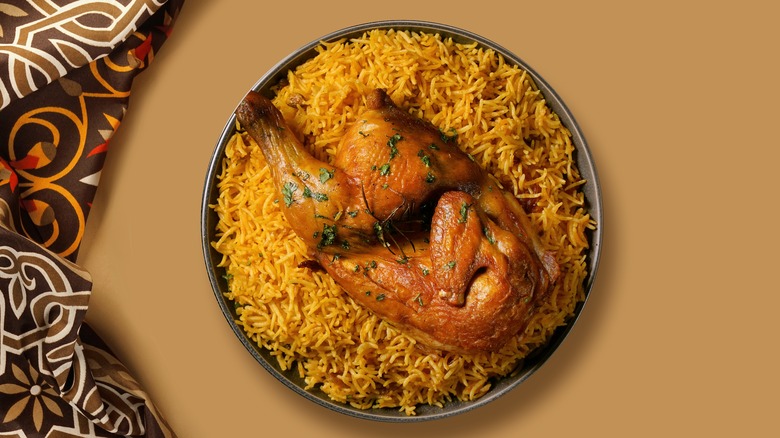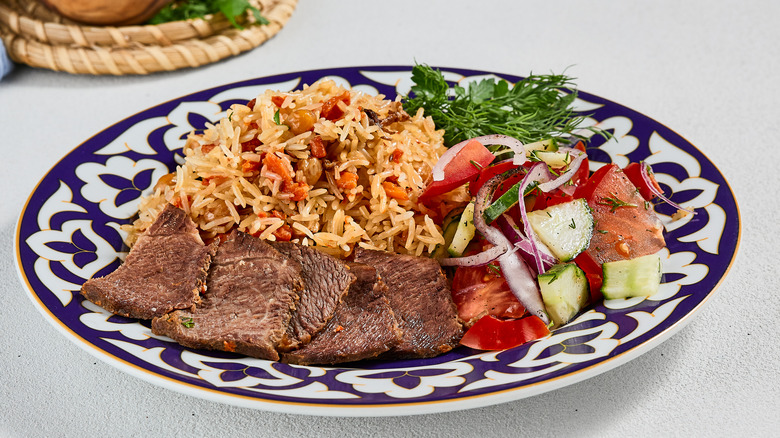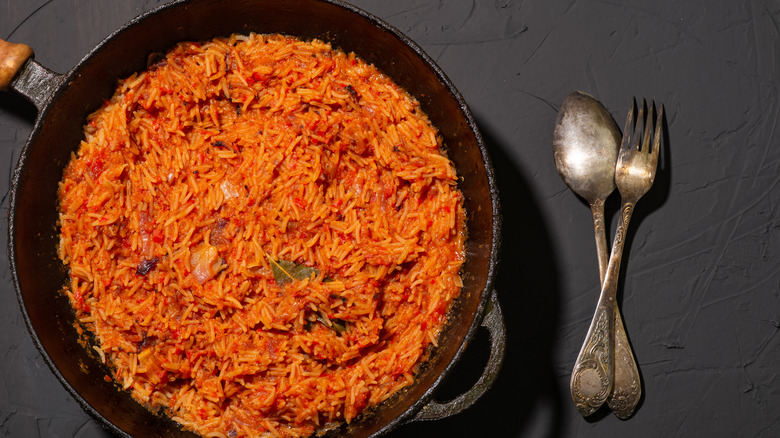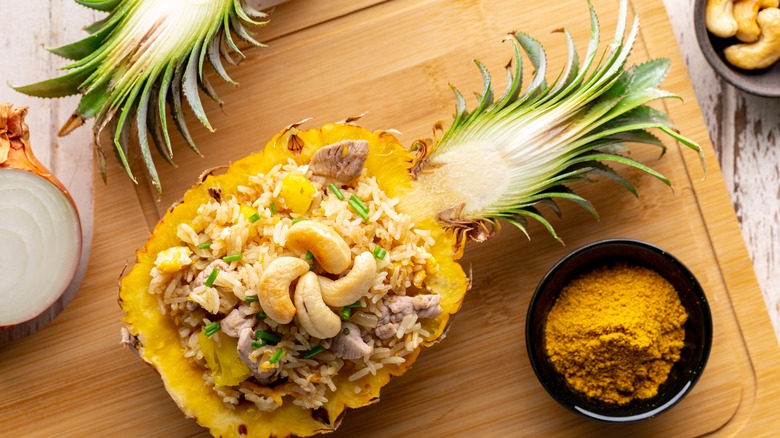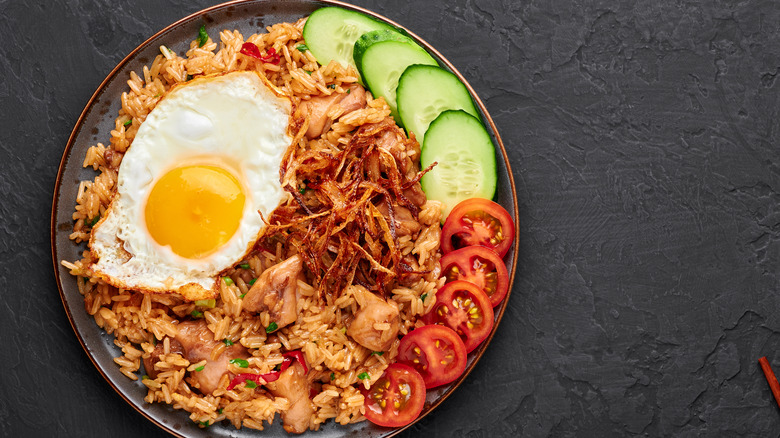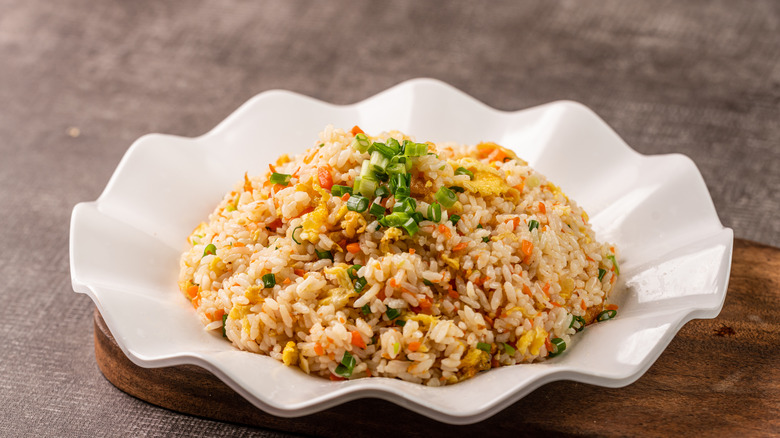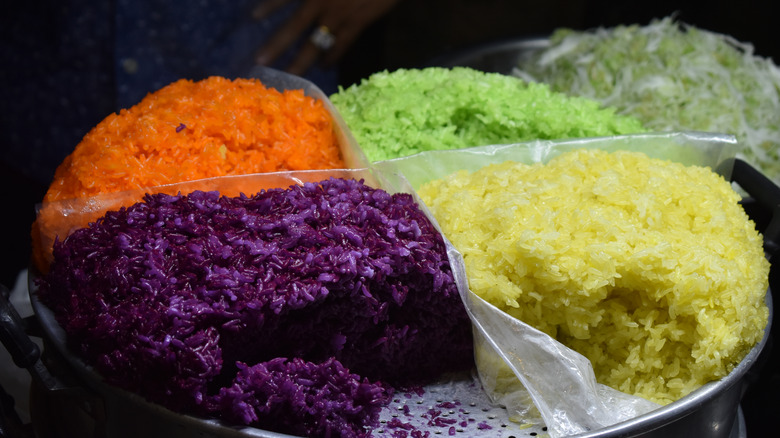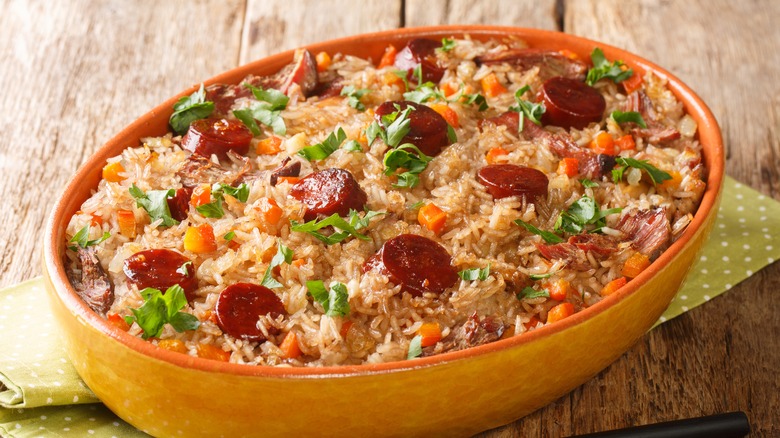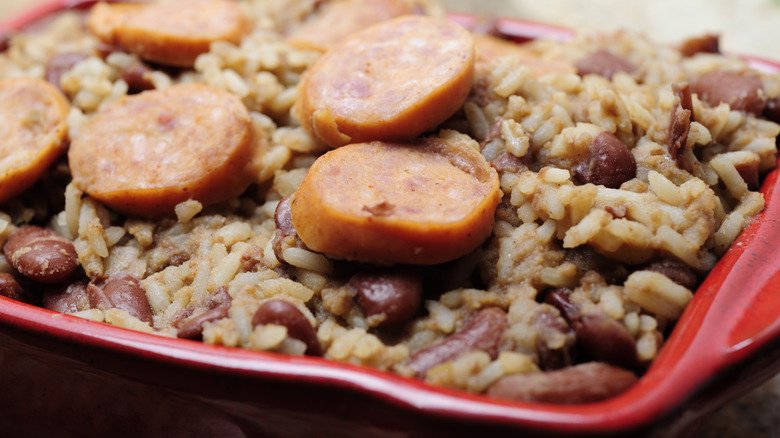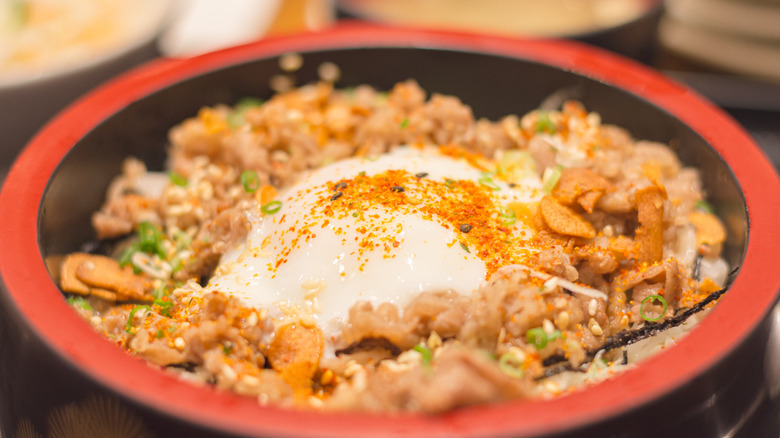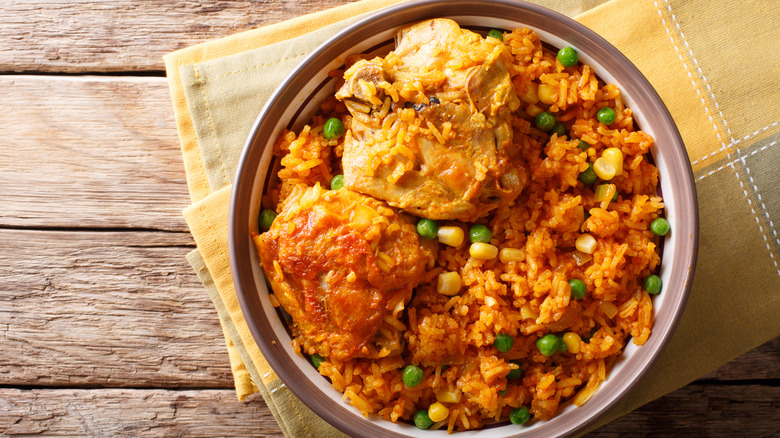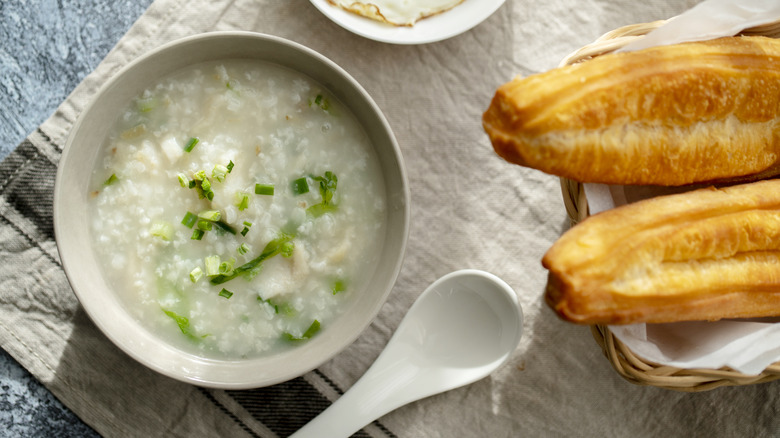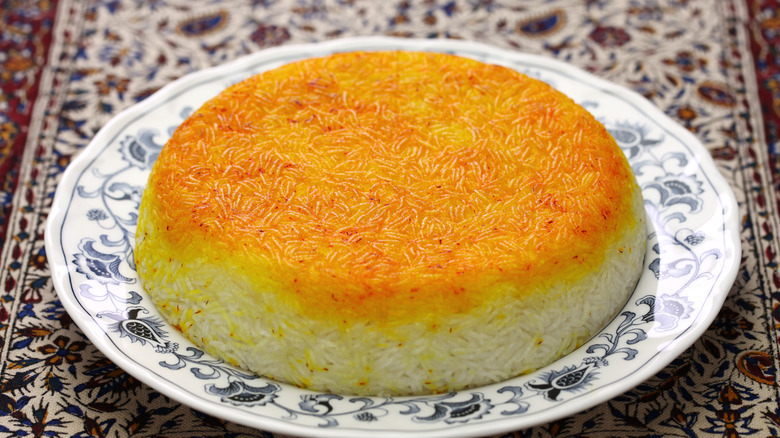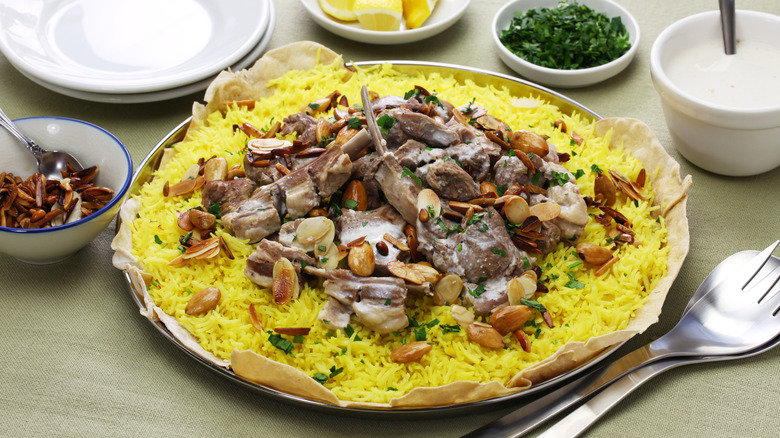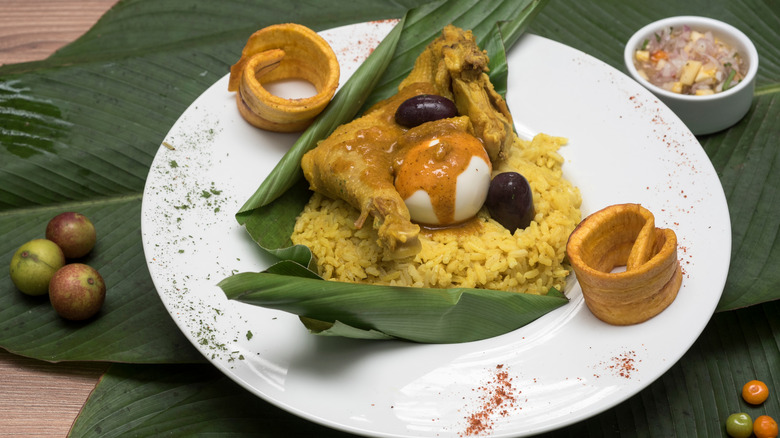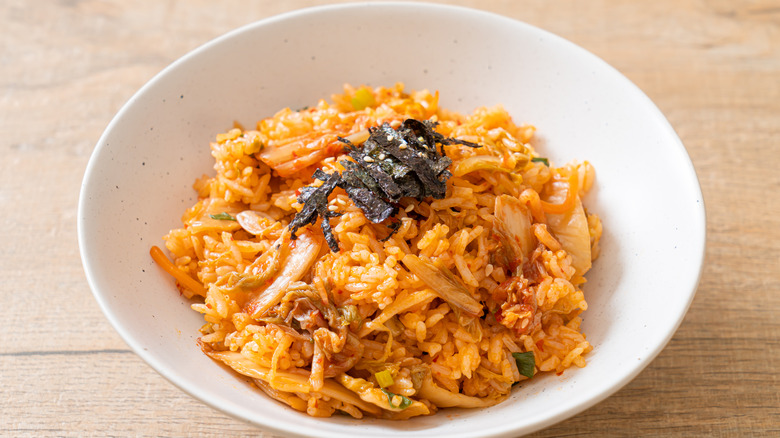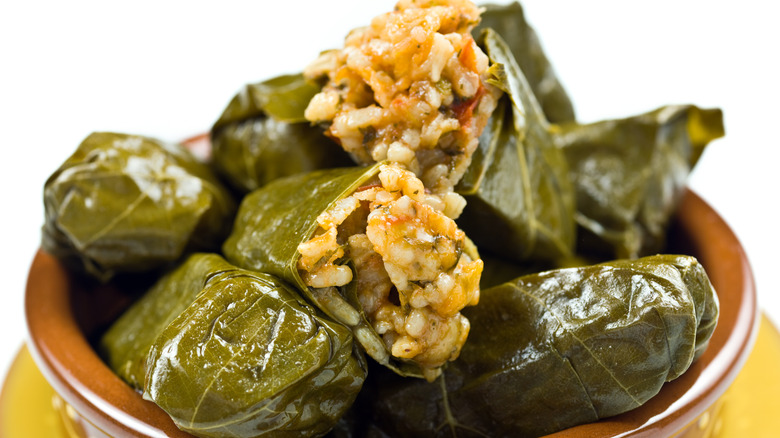28 Rice Dishes Around The World You Need To Try
Regardless of whether we're talking about politics, religions, or customs from around the world, we tend to focus on the differences that divide us rather than the similarities that bring us together. That's also true when it comes to cuisine. Once more, we look at unfamiliar ingredients, historic cooking methods, and unknown spice blends with an us-and-them mentality. Well, we say enough is enough. What if we looked at cuisine as a way of bridging gaps and making ties with people who are different from us? We can't be certain, but perhaps it would allow us to come together in a world that feels increasingly polarized. After all, everyone needs to eat.
And what better way to get to know each other than through rice dishes? Rice is a simple, inexpensive staple food in pretty much every country on the planet. On top of that, many countries have at least one rice dish that they hold dearly. So, let's take a break from the fighting (if only long enough to read this article) as we explore rice dishes around the world you need to try.
1. Sushi (Japan)
A rice dish that needs no introduction. This worldwide favorite is made by combining vinegared rice with raw fish (sashimi), vegetables, and seaweed (nori). One of the most magnificent things about sushi is the number of different forms available. For example, there's nigiri, a simple preparation that involves smearing wasabi paste on top of a ball of rice, then adding raw fish or other seafood on top.
Maki are a bit more complex. They consist of seaweed-wrapped rice rolled around a fish, seafood, or vegetable core. Regardless of the preparation style, you'll find sushi served alongside soy sauce, wasabi, and pickled ginger.
2. Paella (Spain)
The recipe for paella includes saffron-scented Bomba rice (also called Calasparra or Valencia rice), meat, seafood, and vegetables. Everything is cooked together in a paellera, a large shallow frying pan with two handles on either side. Conveniently, this pan doubles as a serving dish. It's most closely associated with Valencia, a rice-growing region on Spain's Mediterranean coast.
Although there is some debate about its origins, the version we know today dates back to the 18th century. At that time, it was a favorite lunchtime meal among farmers and laborers. These paella pioneers combined rice with tomatoes, onions, beans, snails, and whatever else they could find in the immediate vicinity.
3. Biryani (India)
Check out the menu at an Indian restaurant anywhere around the world and you're almost guaranteed to see this beloved Indian rice dish. If you're looking to make biryani at home, you'll need long-grained rice (usually basmati) and fragrant spices such as cinnamon, cloves, fennel, and nutmeg. Meat, such as lamb or chicken, are also important ingredients.
Biryani is typically prepared using the dum pukht method, a slow-cooking preparation that involves layering rice, meat, spices, fried onions, and saffron-infused milk in a sealed pot. The pot is then cooked over a low flame. It's a lot of work, but this method ensures that all of the flavors blend together seamlessly.
4. Jambalaya (United States)
The main ingredients in this one-pot Cajun and Creole dish from Louisiana are long-grain rice, chicken, andouille sausage, and local seafood (usually shrimp and mussels). Beyond that, you'll also find the New Orleans holy trinity, an aromatic base consisting of onions, green bell peppers, and celery. And don't forget the spices! Jambalaya contains a healthy dose of heat thanks to the addition of cayenne pepper and hot sauce.
Although the Cajun and Creole preparations have a lot in common, there's one main distinction to be aware of. Whereas Creole jambalaya contains tomato, the Cajun version does not. Jambalaya is hearty by itself, but no one will complain if you serve it alongside cornbread or collard greens.
5. Nasi lemak (Malaysia)
Nasi lemak came to Malaysia by way of India, but the locals have adopted it as their own. So much so that it's arguably the country's most famous meal. You'll find the coconut-scented rice dish in cafés, street carts, and even convenience stores throughout the Malaysian Peninsula.
Along with the rice (which is infused with floral pandan leaves), nasi lemak is served with sliced cucumbers, fried anchovies, peanuts, and boiled eggs. Everything is topped with sambal, a spicy paste made from red chili peppers, shrimp paste, fish sauce, and tamarind. Locals serve it steaming hot, packed in a banana leaf.
6. Bánh tét (Vietnam)
A traditional Lunar New Year dish in Southern Vietnam, bánh tét are savory (and sometimes sweet) rice cakes made by wrapping mung beans and pork belly in glutinous rice. The ingredients are then encased in banana leaves, secured with ties, and rolled into logs before boiling for six hours or more. After cooking, the cylinders are sliced into bite-sized rounds for easy snacking.
The sweet version, called bánh tét chuoi, is made with ripe bananas and black beans. Locals serve the savory version as part of a larger meal with cu cai nuoc mam (daikon radish pickled in fish sauce) and thit kho nuoc cot dua (pork cooked with coconut juice).
7. Risotto (Italy)
Pizza and pasta are Italy's two big culinary heavy-hitters, but everyone knows that risotto is where it's at. Originally coming from the Lombardy region, this hearty, scrumptious dish is made by slow-cooking Arborio rice (an Italian short-grain variety) with broth, parmesan cheese, and other tasty add-ins like mushrooms or seafood.
Although it looks simple on the surface, high-quality risotto requires fresh ingredients, careful preparation, and plenty of attention. Popular variations of the dish include risotto alla milanese, a saffron-infused risotto made with beef marrow, risotto ai frutti di mare, a seafood-heavy version made with clams, shrimp, squid, and mussels, and risotto al limone, a simple preparation infused with lemon juice.
8. Hainanese Chicken Rice (Singapore)
The name (and even the presentation) of this Singaporean dish might not wow you immediately, but as soon as you take the first bite, you'll see what all of the fuss is about. To make Hainanese chicken rice, whole chicken is poached in boiling water for 45 to 50 minutes before getting dunked in an ice bath to stop cooking.
And while the chicken is undeniably tasty, it's the rice that steals the show. Singaporeans prepare it by frying uncooked grains in chicken fat before cooking them in the chicken water. To the liquid is added aromatics such as ginger, garlic, and screwpine leaves. The whole thing is served with sliced cucumbers, bean sprouts, or pickled vegetables.
9. Kabuli pulao (Afghanistan)
Taking its name from the Afghani capital city of Kabul, Kabuli pulao is a pilaf dish topped with tender, slow-cooked chunks of lamb marinated in a masala spice blend (cardamom, clove, cinnamon, and cumin). The rice and lamb are topped with julienned carrots, raisins, and slivered, toasted almonds.
It's a celebratory dish that's typically served during Ramadan, weddings, and other special occasions. What's more, it's considered the national dish of Afghanistan. While the ingredients may not be earth-shattering by themselves, the act of slow-cooking the meat, rice, and spices together creates a harmonious flavor experience that few other rice dishes can match.
10. Bibimbap (South Korea)
With a history dating back to the late 1500s, this colorful bowl-style dish has long been a favorite on the Korean Peninsula. To make it, top white rice with assorted vegetables such as seasoned spinach, seasoned bean sprouts, shiitake mushroom, and carrots. Next, add a sunny-side-up egg to the middle of the bowl.
Some versions include marinated chunks of beef, but that's optional. What's not optional is the bibimbap sauce, a mixture of gochujang, sesame oil, soy sauce, mirin, and garlic. There are actually two versions of this iconic dish — the classic Jeonju preparation served in a metal bowl and the fancier hot stone dolsot bibimbap.
11. Arroz con pollo (Latin America)
Spanish for rice with chicken, this one-pot dish combines long-grain rice, chicken, tomatoes, bell peppers, onion, garlic, and tomatoes. It also relies heavily on a variety of spices for flavor, notably saffron, cumin, oregano, chili powder, and garlic powder.
You'll find variations of this traditional dish throughout Latin America, the Caribbean, and Spain, with each chef putting their own spin on it. For example, you can substitute drumsticks for thighs, crank up (or tone down) the spice level, or experiment with different vegetables. More than anything, it's this flexibility that makes arroz con pollo as tasty as it is user-friendly.
12. Kabsa (Saudi Arabia)
Widely considered Saudi Arabia's national dish, kabsa is a one-pot meal that combines grilled, spiced chicken (or lamb) and aromatic basmati rice. Although the Saudis have adopted it as their own, kabsa originated in Yemen and is enjoyed throughout the Arabian Peninsula.
As with many Middle Eastern dishes, Kabsa owes its rich flavor to spices. In any given recipe, you'll find it scented with cloves, cinnamon, cumin, coriander, ginger, and bay leaves. These spices are combined with onions, garlic, tomato purée, and bone-in chicken. Once the chicken has finished cooking, it's removed from the pan. Then, rice and raisins are cooked in the chicken juices. Finally, the chicken is served on top of the rice for an easy, flavor-packed meal.
13. Plov (Uzbekistan)
Sometimes called a pilaf or palov, plov is the national dish of Uzbekistan, a central Asian country bordering Turkmenistan and Kazakhstan. Like many rice dishes on this list, plov is as delicious as it is versatile. For that reason, you're almost guaranteed to see it served at weddings, parties, and other large events.
This one-pot meal combines long-grain rice with chunks of mutton, onions, carrots, and an aromatic spice blend (garlic, bay leaves, and cumin). Preparation starts by browning the meat in a Dutch oven. To that, onions and sliced carrots are added. The rice, spices, and water come next. From there, the ingredients are left to simmer for about an hour before serving.
14. Jollof rice (West Africa)
Food-related debates run deep, but no culinary war is more heated than the Jollof rice conflict in West Africa. For years, countries like Nigeria, Ghana, Senegal, and Liberia have fought over who makes the best version of this tomato and rice dish. Not only do they argue over which type of rice to use (Ghana opts for basmati, while Nigeria holds tight to long-grained), but they also disagree about fillings.
While Ghanaian and Nigerian Jollof rice recipes call for curry spices, meat, and hot peppers, the Senegalese version incorporates fish, vegetables, and fermented conch. Still, despite their differences, most chefs agree that the rice, vegetables, and meat should be cooked in a tomato base.
15. Pineapple fried rice (Thailand)
Thai cuisine is all about combining salt, sweet, sour, and spicy ingredients. Unsurprisingly, you'll find all of these notes present in pineapple fried rice. This scrumptious dish incorporates coconut-infused jasmine rice, pineapple chunks, cashews, eggs, a protein (shrimp, chicken, or tofu), and spices such as curry powder and white pepper.
The protein and rice are fried in a fish and soy sauce mixture, then pineapple, cashews, and green onions are added. All of the ingredients are deposited into a hollowed-out pineapple before serving. You can serve pineapple fried rice on a regular plate, but the pineapple bowl provides an undeniable visual appeal that will amaze even the most jaded foodies.
16. Nasi goreng (Indonesia)
Pretty much every rice-loving country has its own version of fried rice, and Indonesia is no exception. Nasi goreng is a popular breakfast dish in the archipelagic state. It combines leftover rice with kecap manis (Indonesian sweet soy sauce), shrimp paste, chicken, chili powder, and onion.
The ingredients may sound simple but don't go thinking this is just some other fried rice dish. Thanks to the kecap manis, the rice takes on a beautiful dark brown color and the chicken develops an irresistible caramelized exterior. After the chicken and rice are pan-fried, they're served alongside a fried sunny-side-up egg, sliced cucumbers or tomatoes, and a protein such as chicken satay skewers, ham, or shrimp.
17. Yangzhou fried rice (China)
Even if you've never been to China, you're probably familiar with this classic takeout dish. What you may not know is that the dish takes its name from Yangzhou, a city located in China's Jiangsu province. Legend has it that local sailors created this dish by combining lunch leftovers with fried rice. In repurposing lunch ingredients, they created a novel dinner recipe.
These days, chefs apply the same principle, adding a combination of pork, shrimp, vegetables, and eggs to their recipes. That said, there are some tips to be aware of. First, cook raw meats before incorporating them into the rice. Second, avoid using vegetables with a high water content. Lastly, cut the meat and vegetables into similarly-sized pieces.
18. Xôi ngũ sắc (Vietnam)
For those of you who don't speak Vietnamese, xôi ngũ sắc means five-colored sticky rice. This bright dish comes from the Tay, an ethnic group native to Sapa, a remote town in northwestern Vietnam.
In addition to savory and sweet notes, xôi ngũ sắc is infused with meaning. Each color represents something different. Red symbolizes fire, green is for wood, yellow represents the earth, black means water, and white is metal. Red, yellow, and green rice are obligatory but the other colors may differ depending on where it's made. The colors are all natural and come from fruit and leaf extracts. Once dyed, the rice is stacked on top of a banana leaf prior to serving.
19. Arroz de pato (Portugal)
If you're taking a trip to Portugal, make sure to add arroz de pato to your list of Portuguese foods to try. This dish, whose name means duck rice, was originally prepared using wild duck. Nowadays, most varieties are prepared with domesticated poultry, but it's no less delicious than the original.
Preparation begins by cooking the meat in its own fat. Next, the country's native port wine is used to deglaze the pan. Then, the poultry is simmered with broth, chorizo, bay leaf, Carolino rice, and seasonings before heading to the oven for 15 minutes. Serve it piping hot with a glass of Aragonês red wine for the full Portuguese experience.
20. Red beans and rice (United States)
Like all great rice dishes, red beans and rice was the product of necessity. The true history goes back centuries, but this dish gained popularity in New Orleans sometime during the 1930s. At that time, it was adopted as an easy Monday night meal for busy housewives. They'd set the ingredients on the stove at the start of the day, then this hearty meal would be ready by the time they'd finished their daily chores.
Aside from the eponymous ingredients, this recipe calls for yellow onion, green bell pepper, Creole seasoning, cooked rice, and smoked sausage (either kielbasa or andouille). All of the ingredients (except the rice) simmer for five hours, or until the beans are tender.
21. Gyūdon (Japan)
Also called gyūmeshi, this Japanese beef rice bowl is made by topping freshly steamed rice with shaved beef and onion that have been simmered in a sauce made from dashi, soy sauce, sugar, and mirin. While simple, this sauce lends all kinds of umami goodness to this popular dish.
If you want to keep things simple, top the rice with the beef and onion mixture. However, if you want to add a bit of pizazz, then add a raw egg yolk (tsukimi yyudon), a poached egg (gyudon with onsen tamago), some shredded scallions, sesame seeds, and crushed red pepper.
22. Galinhada (Brazil)
A popular comfort food in Brazil, galinhada is essentially just a chicken stew. But don't let the basic ingredients fool you — galinhada is packed with flavor that will have you craving more right from the first bite. The secret is the chicken marinade made from olive oil, garlic turmeric, vinegar, salt, and pepper.
Allow the chicken to soak in the mixture for at least two hours. Once the chicken is ready, cook it with sausage (Calabresa, kielbasa, or chorizo) and vegetables (onions and carrots). Simmer in chicken broth for 15 minutes, then add rice before cooking for an additional 15 minutes.
23. Congee (China)
You might not think of rice as a breakfast item, but in China and other Asian countries, it's a morning staple. Lots of different preparations exist, but none is more popular than congee, a savory rice porridge. The simplest recipes call for just three ingredients: rice, water, and salt. The rice is cooked over low heat for 45 minutes, or until it becomes thick and creamy.
This recipe is great if you're under the weather, but most people jazz it up by adding soy sauce, sesame oil, scallions, and a soft-boiled egg. Keep in mind that these are just suggestions. Congee lends itself well to experimentation, so try adding meat, ginger, tofu, or vegetables.
24. Tahdig (Iran)
Most of the time, crispy rice is seen as the result of inattention or lack of skill. That's not the case with tahdig, a traditional rice dish from Iran. Tahdig means "bottom of the pot," and this translation gives some insight into the dish's preparation.
The perfect tahdig starts with saffron-infused basmati rice cooked in a cast-iron pot. When cooked slowly, the heat of the pan causes the rice to develop a crispy crust. This process can take up to an hour and a half, but it's worth the wait. When you unmold it, you'll be greeted with a gorgeous yellow-colored mound of rice. Top the rice with parsley, dill, or dried fruit.
25. Mansaf (Jordan)
Originally a Bedouin recipe, now mansaf is Jordan's national dish, and it's easy to see why. This hearty meal is usually served family-style, making it an excellent option for weddings, birthdays, or other special occasions.
Shrak, a thin flatbread, forms the base of the dish. Laban jameed, a sauce made from fermented goat's milk, is poured on top, followed by rice and meat (usually lamb, but chicken or camel are also possible). More of the laban jameed sauce is added on top and the dish is finished with pine nuts or slivered almonds. Jordanians eat it with their hands, rolling the lamb, bread, and rice into a ball before popping it into their mouths.
26. Juane (Peru)
You've likely heard of ceviche and pisco sours, but what about juane? Originating from the jungles of Peru, this traditional dish is made with chicken, olives, hard-boiled eggs, and rice seasoned with spices (turmeric, oregano, and cumin).
After the initial cooking, all of the ingredients are wrapped in bijao leaves (similar to banana leaves) and steamed for 30 minutes. This step requires some extra skill and time but it's worth it. Not only does it boost the flavors, but it also ensures that the chicken stays moist. To serve juanes, unwrap the leaves and place them on a plate alongside cassava or boiled bananas.
27. Kimchi bokkeumbap (South Korea)
It's not often that Koreans have leftover kimchi, but when they do, they make kimchi bokkeumbap, a spicy, easy-to-prepare fried rice dish. This beloved comfort food is prepared by tossing day-old rice into a pan, then adding kimchi and kimchi juice into the mix.
This popular fermented cabbage side dish adds just the right amount of spice and tanginess to liven up the other ingredients. What these ingredients are depends entirely on who's making kimchi bokkeumbap. Vegetarians can stick to veggies and tofu, while carnivores can play around with cubed Spam or bacon. Regardless of the ingredients you choose, finish with an egg fried in sesame oil and some chopped green onions.
28. Dolma (Turkey)
If you're anything like us, you probably associate dolmas with Greek cuisine. While you're likely to find these stuffed grape leaves everywhere from Athens to Zakynthos, they actually originated in Turkey. The Turks hold them so dear, in fact, that they've long been considered the country's national dish.
It's important to point out that the Turkish version isn't limited to grape leaves. Rather, it refers to any vegetable stuffed with a rice-based mixture. For that reason, you'll easily find stuffed eggplants, zucchini, and bell peppers in Turkey. These veggies are stuffed with a rice mixture that combines olive oil, pine nuts, currants, and spices (cinnamon, allspice, and parsley).
Static Media owns and operates Tasting Table, Mashed, and The Daily Meal.
